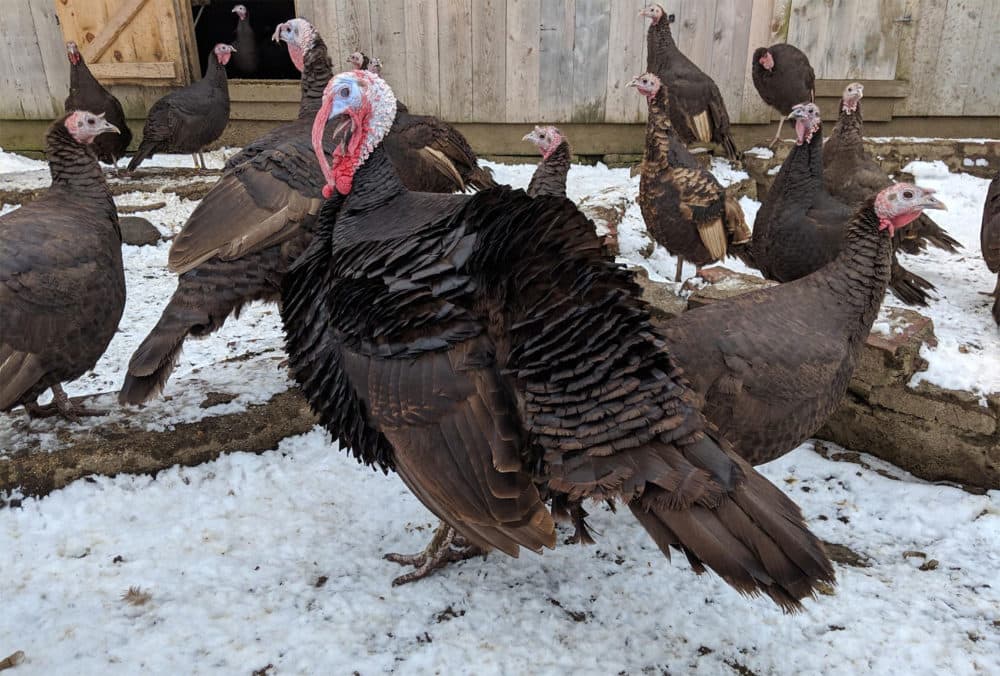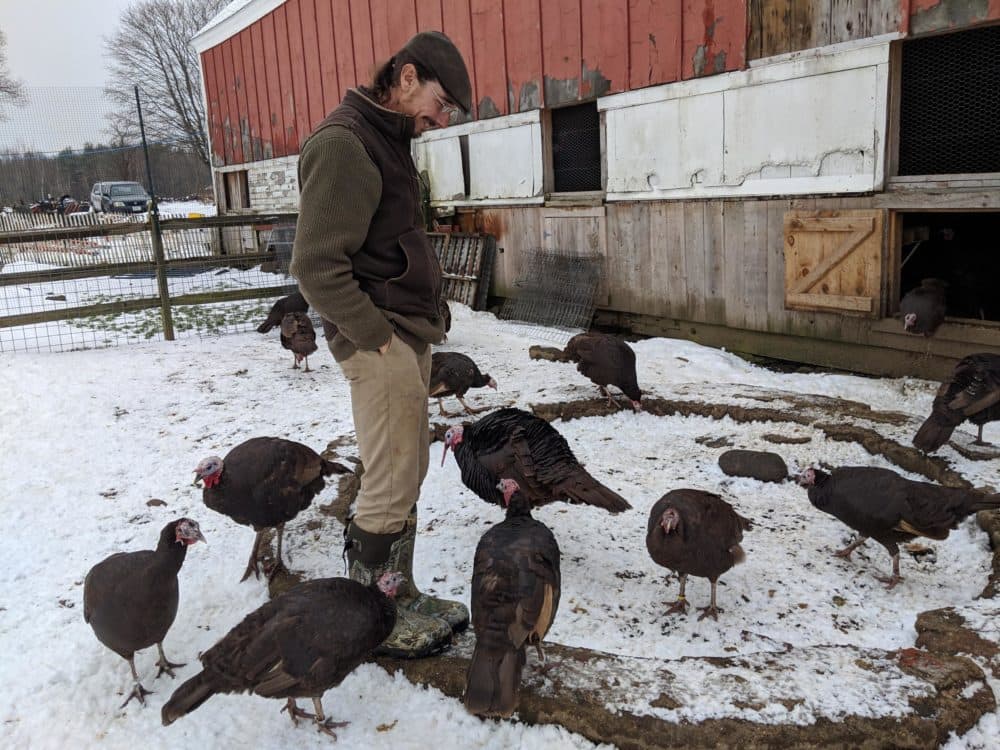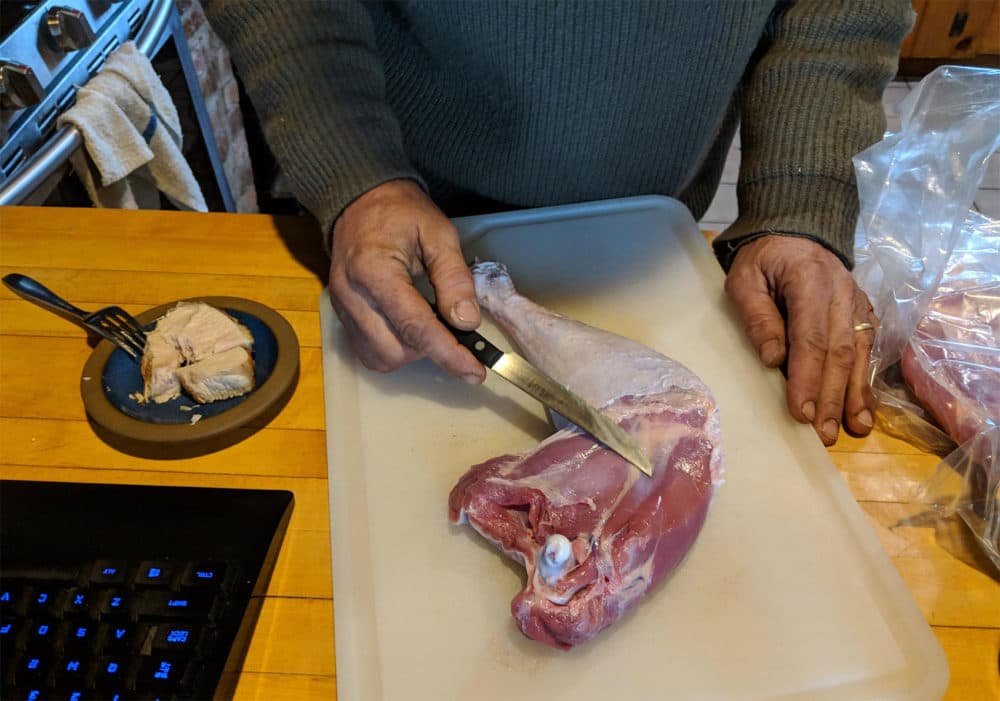Advertisement
The Last Chocolate Turkeys: N.H. Farmer Ends Effort To Sustain Endangered Breed
Resume
Birds are an inescapable presence at Élevage de Volailles, the farm in Loudon, New Hampshire, that Jim Czack owns and operates with his partner Annette. There are Pekin ducks, Cornish chickens and a menacing pack of stocky Embden geese.
But most of all, there are the Chocolate turkeys — about 100 of them, their dark-brown plumage striking against the snow.
“Who’s got a story to tell? Huh?” Czack asks the Chocolates as they cluster at the edge of their enclosure, peering upward and gobbling inquisitively.
“They have their little turkey thoughts, and you see the gears going, and that can get you into a lot of trouble,” he says. “Are they a beginner’s bird? No, they are definitely not a beginner’s bird.”
Czack used to breed horses, but for nearly a decade, he’s been pouring his life’s savings into a Chocolate turkey breeding program — studying what makes them unique, and mating his best specimens to create new generations of better birds.
He’s trying to resurrect history. The story goes that the dindon de chocolat was first bred from black turkeys by Jesuit monks in France in the 1500s.

Czack thinks his birds, in a roundabout way, are descended from those. But not everyone is so sure.
The American Poultry Association doesn’t recognize the breed. And Jeanette Beranger of the American Livestock Conservancy says the Chocolates’ lineage is pretty thin.
“I can’t tell you if those genetics are still around today,” she says. “You know, the evidence indicates that the Chocolates are largely a recreation of that color variety.”
Czack’s other problem is that his turkeys cost $8 a pound. They can’t compete with the grocery store Butterball.
He says his Chocolates cost so much because they’re expensive to breed and raise — but he thinks they’re worth the price.
In his kitchen — next to a cage full of twittering finches, of course — Czack cuts me a slice of cold Chocolate turkey from the previous night’s dinner.

And it does taste different than any turkey I can remember having. It’s tender and moist, with a richer, more complex flavor than I’m used to.
Czack says this is because it grows slower than other breeds, developing more fat and muscle than commercial birds. A stress-free lifestyle and decadent diet don’t hurt, either.
During the breeding program, Czack would sell three or four dozen turkeys a year for Thanksgiving meals.
And he supplied poultry for two chefs at high-end New Hampshire restaurants.
Corey Fletcher is one of those chefs; he runs Revival in Concord.
“It’s unfortunate because [Czack’s] product is so good and so different that the public is not used to it, because they’ve never had it before,” Fletcher says.
Out in the yard, Czack ruffles the feathers of one of his turkeys as she pecks at his boots.
“If you can touch me, I can touch you,” he teases her. “Is that fair?”
The turkey hops around his ankles. She doesn’t seem to know she could be the last of a long line — but Czack does.
He believes his could be the last formal breeding program for Chocolates, and the breed is critically endangered. His current flock represents about a fifth of the global population.
“I looked at this turkey and I said, 'I can make a difference,' ” Czack says. “And it was a little bit naïve because one person can’t make a difference.”
Not when supermarket turkey prices are lower than ever.
But the difference is about more than taste or pretty feathers. Older, hardier varieties of poultry can carry useful immunities and other rare traits.
And commercial turkeys have been bred to grow so meaty so fast, they can no longer reproduce or raise chicks on their own.
Czack hopes that someday, someone with more funding might revive the Chocolate turkey again. Until then, he’s sold around 50 birds for Thanksgiving this year, and plans to give some more to local chefs.
He’ll keep 14 of his best birds in the yard. The rest will stock his freezer.
This story was first published by New Hampshire Public Radio.
This segment aired on November 22, 2018.